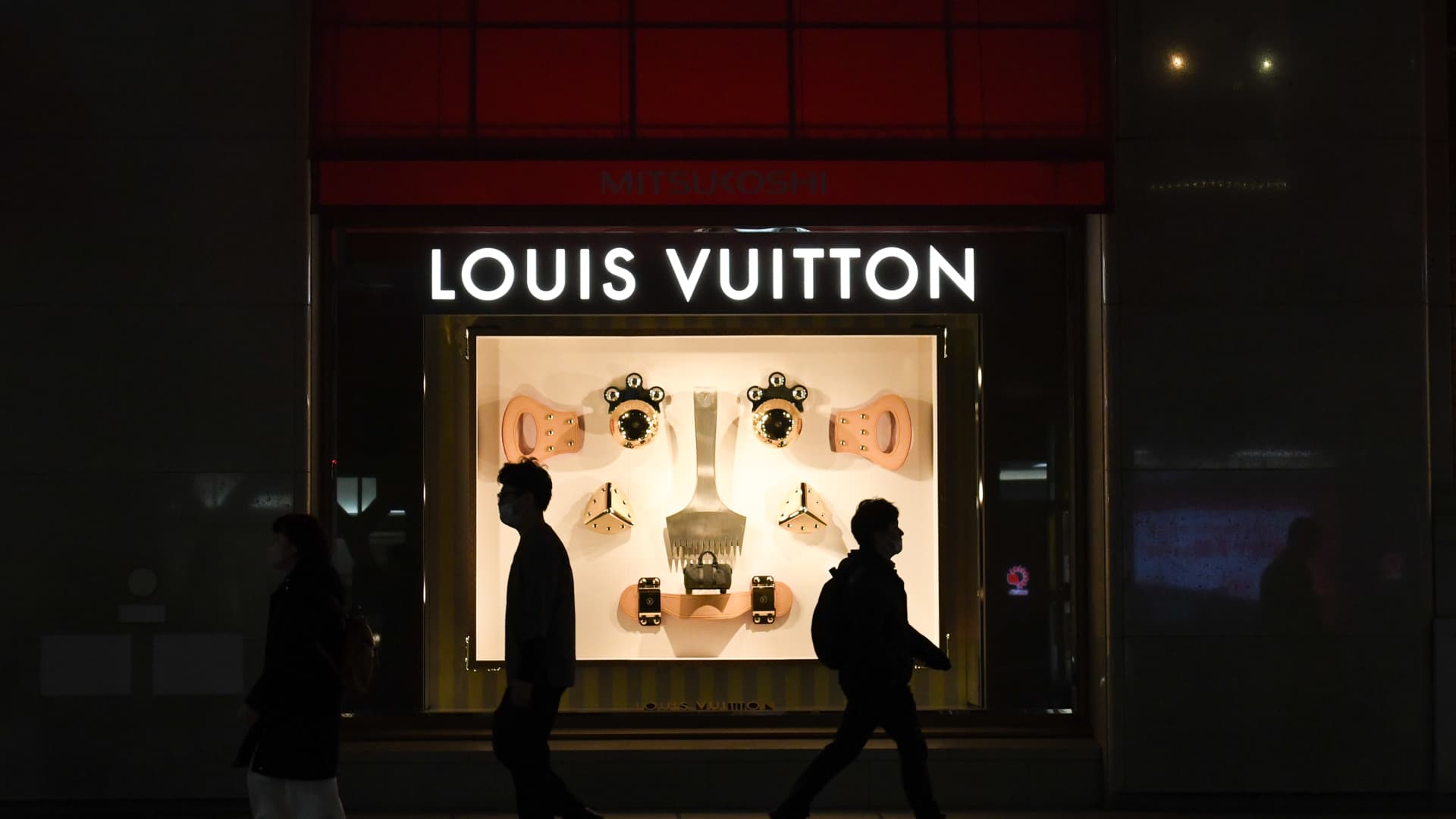LVMH shares fell 7.8% following a 3% decline in first-quarter sales, causing the luxury giant to lose its title as the world’s largest luxury firm to Hermès. The disappointing results, attributed to weak demand for cognac in the U.S. and China, led to declines in stocks across the luxury sector, including Kering and Burberry. Analysts noted limited growth visibility amid economic uncertainties and trade tensions. While Europe saw a 2% increase in organic sales, Asia and the U.S. reported significant declines. Challenges include potential tariff impacts on supply chains and consumer demand, complicating future recovery for luxury brands.
Display at the Louis Vuitton store in Mitsukoshi department store, Tokyo, Japan, on Friday, April 4, 2025.
Bloomberg | Getty Images
Shares of LVMH dropped by 7.8% on Tuesday, ceding its title as the largest luxury company globally to competitor Hermès following an unexpected fall in first-quarter sales.
LVMH announced a 3% year-over-year decrease in first-quarter sales in a trading update released shortly after the market closed on Monday, falling short of analyst consensus expectations for minimal growth.
This resulted in a decline for the broader sector during morning trading, despite gains in the overall market. Shares of Kering saw a 5.2% decline, Burberry decreased by 4.6%, and Richemont traded down 0.9%.
LVMH’s shares were on track for its worst trading session since March 2020. Meanwhile, a 0.2% rise in Hermès’ share price allowed the Birkin bag producer’s market value to surpass that of LVMH.
By the afternoon, LVMH’s market capitalization was at 244.1 billion euros ($275.4 billion), compared to Hermès’ 246.4 billion euros, according to a CNBC analysis of FactSet data.
LVMH share price.
From 2021, LVMH spent several years as Europe’s most valuable company, as luxury stocks thrived due to expectations of a post-Covid-19 pandemic boom. Since its peak in 2023, it has lost more than 45% of its value.
The company was surpassed by Danish pharmaceutical company Novo Nordisk in late 2023, only to be overtaken by German software company SAP in March 2025.
First-quarter decline
In the first quarter, LVMH’s wines and spirits division experienced the most significant revenue drop, down 9%, highlighting weaker demand for cognac in the U.S. and China, attributed to geopolitical tensions.
The important fashion and leather goods sector, which represented 78% of profit in 2024, fell by 5%, while watch sales remained unchanged.
Only Europe saw growth, increasing by 2% on an organic basis. Sales in Asia excluding Japan dropped by 11%, U.S. sales fell by 3%, and Japan saw a decrease of 1%.
Citi analysts Thomas Chauvet and Mahesh Mohankumar remarked in a Monday evening note that there was “not much to celebrate at the luxury bellwether,” with sales “overall below even the most conservative buyside expectations.”
They suggested that without clarity on the U.S. and global economic landscape, it’s challenging to predict sequential revenue improvement in the second and third quarters for either LVMH or the luxury sector.
“While structural growth factors persist, short-term visibility remains very constrained, particularly considering trade tensions and tariffs… The next positive catalyst for LVMH/the sector may need to arise from an unexpected macro event, as fundamentals are likely to remain challenging in the near term,” Bank of America Global Research analysts noted.
Impact of tariffs
The luxury sector, which heavily depends on global supply chains and U.S. consumer spending, is encountering multiple challenges stemming from U.S. President Donald Trump’s erratic trade policies.
LVMH, owner of brands like Louis Vuitton, Moët & Chandon, and Hennessy, is the first major European luxury player to disclose first-quarter results since Trump revealed and subsequently postponed reciprocal tariffs on its trading partners worldwide.
Consequently, investors are keen for the firms’ outlook regarding the potential effects of tariffs on production costs and consumer interest.
LVMH CFO Cecile Cabanis informed analysts during a Monday call that the group had not detected a “significant change in trend” during the first quarter, noting steady growth over the past six months.
“It’s true that aspirational customers are always more susceptible in less favorable economic periods, which could have affected some categories recently, particularly wines and spirits and beauty,” Cabanis mentioned, according to a FactSet transcript.
Although Cabanis refrained from commenting explicitly on pricing for the second quarter, she indicated that the company is considering repricing its products to moderately counteract inflation or currency fluctuations.
Luxury brands are expected to be somewhat insulated from the immediate effects of tariffs, as premium labels usually find it easier to transfer added costs to affluent consumers.
Nevertheless, analysts caution that the risk of a tariff-driven economic downturn could significantly impact demand—especially in key U.S. and Chinese markets—potentially prolonging the sector’s recovery from a long-standing weakness.
